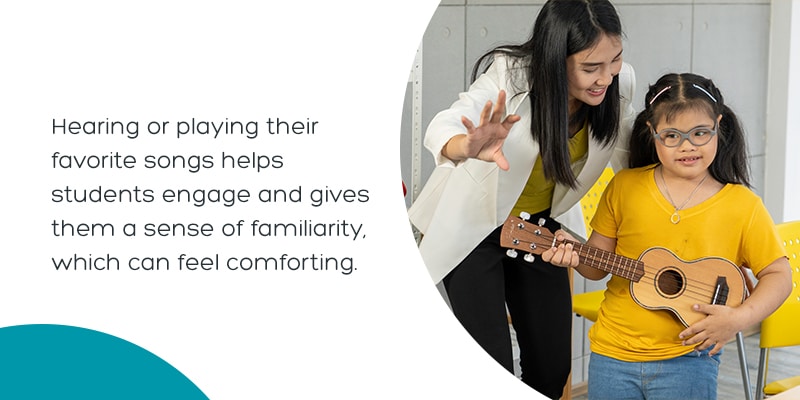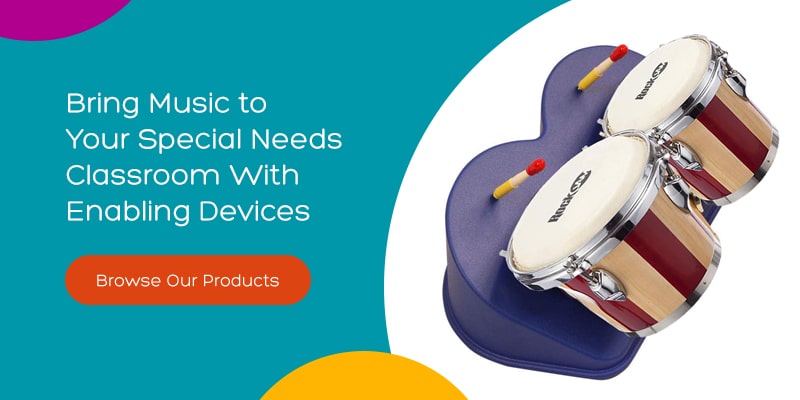Children with functional needs (commonly referred to as special needs) benefit from experiencing and learning music. Music is an effective learning tool for students with Autism Spectrum Disorder, cerebral palsy, intellectual disabilities and more.
Music is a creative tool that can positively affect children through emotional understanding, empathy, communication and empowerment. Besides the musical benefits, these lessons can impact a student’s life in other areas of their education and beyond the classroom in their social and emotional development.
A music lesson for a special needs class should consider each student’s abilities and use a device or method that works for them. Plan a music lesson where students can learn about music while having fun.
How Music Can Help Children With Functional Needs
Children with functional needs benefit from music education. The following music activities can develop skills that students can use in the classroom:
- Listening to music increases focus.
- Singing enhances communication skills and improves speech.
- Memorizing lyrics can improve a student’s ability to remember academic concepts.
- Rhythm develops and refines motor skills.
Where a traditional classroom uses mostly auditory and visual senses, a music classroom involves other senses to encourage participation in unique ways. Sensory music for special needs classrooms engages students’ tactile systems. A multisensory experience with music can be positive for students.
You can adapt music lessons to the unique needs of each child to engage them. For example, music therapy for students with hearing impairment can improve their speech and language development, social and emotional development, listening skills, and cognitive development. These activities can involve music and pitch perception depending on the child’s abilities. Vibration music benefits students who are deaf or hard of hearing because they can use percussive instruments, vibrations and visual cues to understand rhythmic patterns.
How to Adapt Music for Students With Special Needs
You can teach music to your students in various ways to help your class stay engaged. These techniques can help you have a successful music lesson.
1. Use Visual Support
Visual aids in your music lessons can help your students understand how to do the activity. The auditory stimuli of music and the visual cue of a card or demonstration enhance comprehension and memory by engaging multiple senses.
Here are some ideas for using visual support in your music lessons:
- When you want students to clap to a song, if they are able, hold a card that says “clap” with a picture of hands.
- Pictures, gestures, cards and storybooks with a song can help students understand the lyrics.
- When presenting a choice, such as asking the students which song they want to sing or which instrument they want to play, hold up cards or the item itself.
2. Incorporate Their Favorite Songs

Your students will enjoy music lessons with songs they know and are appropriate for their actual and development ages. Hearing or playing their favorite songs helps students engage and gives them a sense of familiarity, which can feel comforting. You can use familiar songs as a teaching tool through activities like:
- Having students read the lyrics out loud.
- Circling unfamiliar vocabulary words or key words in the lyrics.
- Discussing what the song means.
- Writing about the song’s themes or meaning.
3. Use Rhythm
Rhythm is an important component of music and music lessons for students with special needs. Rhythm emphasizes the song’s key words, creates a predictable cadence and engages the student’s body with the activity. Rhythm lessons can work better than verbal instructions for students who need help filtering important information in dialog.
Using rhythm can be as simple as students tapping the table, a drum or their leg. They can tap a beat to a simple chant to understand rhythm. For students who speak too fast, have them tap the syllables of their words to slow their pace and improve articulation.
4. Keep the Music Going
You can use what students learn in music class in other areas of their learning. Generalizing music concepts can help students apply what they’ve learned in their lessons for math, reading or other areas. Keep music lessons going in these ways:
- Teach the students a song about classroom behavior and play the song throughout the day to reinforce the lesson. Later, you can simply speak the lyrics as a cue for the students.
- Use your visual aids from a song during other activities. For example, hold up the picture cards for your classroom behavior song when you want them to actually practice the behavior.
- Play a song, then ask them about the who, where, when, what and why of the song. This lesson helps students understand and make connections with the song’s lyrics.
5. Provide Non-Speaking Options
Though some components of music are verbal, like singing, students can engage with music without using words. Some students may have difficulty processing words, communicating or expressing their feelings, and they may engage with a song better in non-verbal ways.
Here are ideas for non-speaking options in your music lessons:
- Instead of asking for a verbal answer, have your students play a game to demonstrate their knowledge about what you just taught them.
- Create a choice chart so students can indicate the option they want instead of saying it out loud.
- Play a song for your students, then have them draw a picture or write about the song.
Bring Music to Your Special Needs Classroom With Enabling Devices
Enabling Devices works with parents and teachers of children and adults with special needs to create devices that teach music appreciation. Your students will love our:
- Adapted Music Kit that includes Ring Around Bells, Band Jam and other toys that use music to improve stress management, communication skills and more
- B Woofer Guitar that plays songs, chords and strings through switch activation to teach cause and effect and improve auditory development
- Bongo Drums that use two capability switches to hit the drums and produce a sound
- Spinning Symphony that plays six Mozart compositions and turns around to access switches for violin, piano, French horn, flute and harp
We can help you find the right toys to engage your students and help them achieve their goals inside and outside the music classroom. Contact Enabling Devices today for more information about our music products and other adaptive devices.



